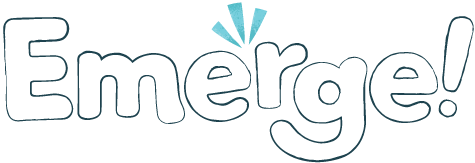1. Model Routines
Students receive targeted and explicit modeling from a variety of phoneme awareness, decoding, encoding, and high-frequency word routines.
1. Model Routines
The Emerge! instructional model takes an explicit, systematic approach to teaching foundational skills, comprehension and knowledge building, and writing about texts and topics—cohesively connecting the strands needed for skilled reading and writing.
For K–1 classrooms, Emerge! guides students and teachers through 12 three-week long units. Each strand draws on research-based routines and a gradual release framework to transform leading literacy research into actionable practices.

(45–50 minutes)
Foundational skills are critical to building lifelong literacy; without them, complex learning cannot take place. With instruction and time, these skills become increasingly automatic, working in tandem to help students grow into skilled, fluent readers and writers.
Our goal is to make teaching foundational skills as easy and efficient as possible with explicit, systematic, cumulative instruction—a proven strategy for helping students acquire foundational knowledge. As such, our instruction centers on a clear, consistent set of routines that follow a gradual release process to slowly transition students toward independent practice:

Students receive targeted and explicit modeling from a variety of phoneme awareness, decoding, encoding, and high-frequency word routines.
1. Model RoutinesGuided instruction and immediate corrective feedback from the teacher support students as they develop their skills and move toward independent practice.
2. Guide PracticeStudents move toward automaticity, transferring what they’ve learned from isolated word reading to connected texts.
3. Move Toward Automaticity(45–50 minutes)
Even the youngest learners come to the classroom full of rich experiences, perspectives, and prior knowledge. Emerge! activates and builds upon this base of knowledge with text-driven instruction focused on depth and breadth, diving into vertically aligned, cross-disciplinary topics in literature, science, and social studies. Our approach goes a step further to focus on comprehension building, ensuring that students have the tools to fully grasp what they’re reading to begin building these vast networks of knowledge.
Features of the Building Comprehension and Knowledge strand for K–1 include:
(Lesson durations vary)
In the words of program author Dr. Steve Graham, “Reading and writing are intimately related. Teaching one improves the other. Teaching them together is even better.”
Emerge! leverages this proven phenomenon, otherwise known as the reading-writing connection, by providing students with explicit writing instruction that deepens their understanding of text and topic.
During the building comprehension and knowledge block, students in Grades K–1 focus on the fundamentals of writing and practice emergent writing skills. Once the foundation is set, teachers can choose one of two writing pathways: the Weekly Writing Pathway, grounded in topic and text, or the Extended Writing Pathway, which guides students through the writing process recursively and provides genre-based writing models.

Weekly writing focuses on writing grounded in text and topic. Students use their writing skills and what they’ve learned about the unit topic to work toward writing sentences. At the end of each week and unit, students also use their writing skills to engage in a Culminating Task tied to the knowledge they are building.
Weekly Writing
Starting in Unit 6, students begin to apply their growing writing and grammar skills to longer writing pieces. The Extended Writing lessons follow a gradual release process, moving students recursively through Explain, Model, Guided Practice, and Apply within each phase of the writing process.
Extended Writing
(20 minutes)
Taking place within or following whole-group instruction, Study Group and Independent Time leverage skill and formative teacher observational data to deliver just-in-time instruction aligned to the unit scope and sequence.
Study Group:
While students are engaged in Study Group, the rest of the class works on the same skills and/or texts either independently, with a partner, or in a small group of their own.


(20 minutes)
Focus Group and Independent Time help teachers meet students where they are with instruction that provides support related to any skill or standard, independent of scope and sequence. Focus Group:
While students are in Focus Group, the rest of the class is engaged with independent work.
Emerge! was designed as a continuum for revelatory learning. Over the course of K–5, the lesson model gradually shifts from foundational skills, phonics, and word structure in K–3 to a stronger emphasis on writing and building comprehension and knowledge in 2–5. This structure supports students as they grapple with increasingly complex content, seamlessly building their knowledge and skills as they move from grade to grade.